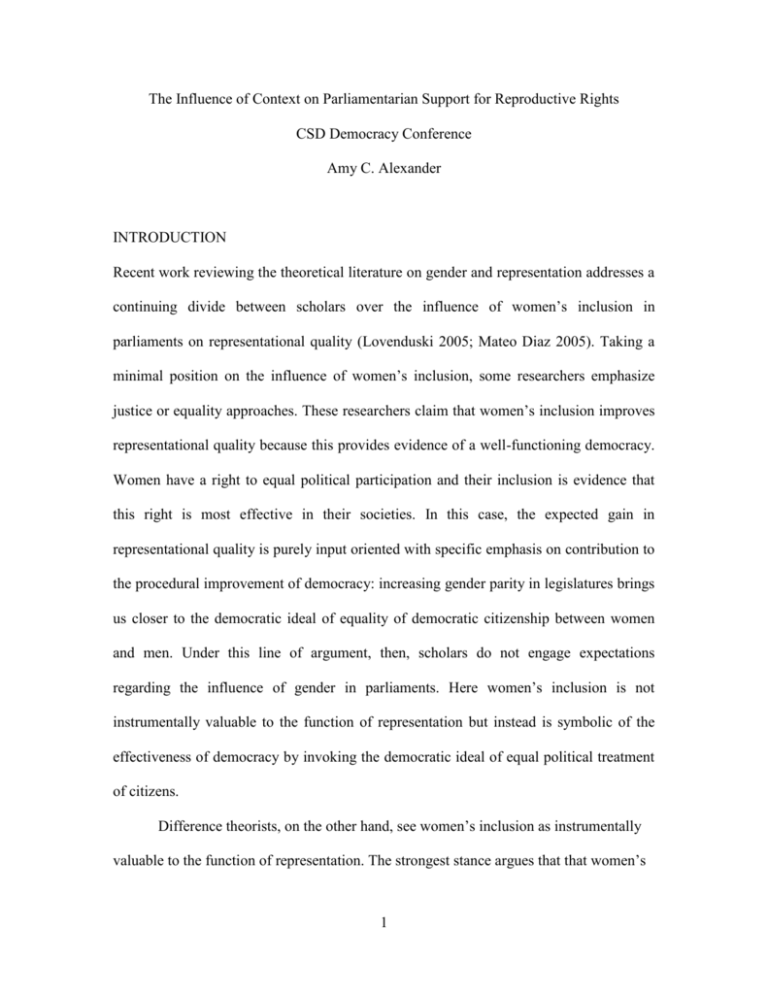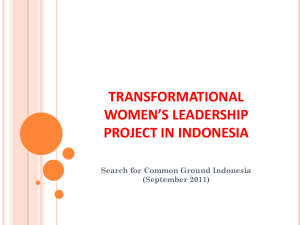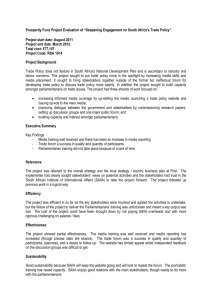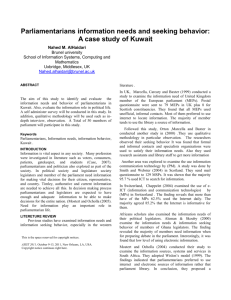The driving core of all considerations of gender and representation
advertisement

The Influence of Context on Parliamentarian Support for Reproductive Rights CSD Democracy Conference Amy C. Alexander INTRODUCTION Recent work reviewing the theoretical literature on gender and representation addresses a continuing divide between scholars over the influence of women’s inclusion in parliaments on representational quality (Lovenduski 2005; Mateo Diaz 2005). Taking a minimal position on the influence of women’s inclusion, some researchers emphasize justice or equality approaches. These researchers claim that women’s inclusion improves representational quality because this provides evidence of a well-functioning democracy. Women have a right to equal political participation and their inclusion is evidence that this right is most effective in their societies. In this case, the expected gain in representational quality is purely input oriented with specific emphasis on contribution to the procedural improvement of democracy: increasing gender parity in legislatures brings us closer to the democratic ideal of equality of democratic citizenship between women and men. Under this line of argument, then, scholars do not engage expectations regarding the influence of gender in parliaments. Here women’s inclusion is not instrumentally valuable to the function of representation but instead is symbolic of the effectiveness of democracy by invoking the democratic ideal of equal political treatment of citizens. Difference theorists, on the other hand, see women’s inclusion as instrumentally valuable to the function of representation. The strongest stance argues that that women’s 1 inclusion improves representational quality due to women’s difference from men. These scholars argue that women’s unique capability to represent new, uncrystallized social needs by virtue of their difference from men by shaping the agenda and more precisely articulating these needs in processes of deliberation improves representational quality (Mansbridge 1999; Williams 1998). This approach is rooted more in a functional understanding of women’s contribution to representational quality as women’s gender in addition to their inclusion creates the grounds for further representational expertise. In particular, it is under the representational cases of women’s interest policies that the difference scholars argue for the functional importance of women’s inclusion. Policies on reproductive rights fall under this special set of policy cases. In this paper, I inform the debate with empirical evidence from cross-national analysis of survey data among west European parliamentarians. In particular, I analyze the gender gap in parliamentarians’ support for a women’s right to choose to have an abortion. However, instead of focusing on whether gender exerts an effect on parliamentarian support for abortion policy, with women showing stronger support than men. I look at the function of gender as something that varies across parliamentarians by stronger or weaker genderegalitarian features in their environments. I test the influence of features at the individual, party and country-levels. I consider whether there is some stability to the gender gap across varied conditions and whether women and men converge or diverge under more gender-egalitarian conditions. I test seven features plausibly conducive to explanations of parliamentarian gender variation in support for abortion policy through comparison of attitudinal differences between female and male national and European parliamentarians across 15 2 European democracies. Indicators standardize and test the influence of the social policy environment of a parliamentarian’s nation, women’s autonomous access to resources in a parliamentarian’s nation, the mass orientations of a parliamentarian’s nation, the party family to which the parliamentarian belongs, the ideology of the parliamentarian, the institutional design elements of the parliamentarian’s nation, and the gender composition of the representational body in which the parliamentarian resides. The Literature Abortion Policy in Europe In her study of abortion policy in four democracies, Yishai (1993) describes nations’ progress in abortion policy as resting on two aspects of the issue: “individual choice and the state’s commitment to this choice” (210). Yishai discusses these aspects in terms of their role in the liberalization and effectiveness of nations’ policies: The first aspect concerns the degree of reproductive freedom available to a woman. Some measure of freedom is allowed in a majority of the countries around the world, though the extent is often predicated on a set of conditions, fetal age, the woman’s age, genetic considerations, and the woman’s health. The greatest degree of freedom in the present context allows a woman to terminate her pregnancy on the basis of subjective considerations…The second aspect is the extent to which the state is committed, through funding and health care facilities, to implementing individual choice by making abortion available to all women, regardless of economic level (210). If we look at aspects of abortion policy across the 15 European democracies analyzed in this study, one sees important variation in the liberalization and effectiveness of the laws (see Table 1). As major players in the policy-making process, parliamentarians will continue to play an important role in developing this policy arena. What is less clear is whether women are most likely to support the continuing 3 development of this liberalization and effectiveness and how improvement in the equal treatment of genders in the wider society affects the gender gap in support for this policy development. Gender-Egalitarian Features Expected to Vary the Gender Gap I test seven features conducive to explanations of variation in the parliamentarian gender gap in support for abortion policy. To identify these features, I draw on literature on influences of cross-national variation in women’s status and equality. The Social Policy Environment. Researchers working in the subfield of gender equality and welfarism note the central role that welfare policy plays in reinforcing or challenging traditional roles for women (Orloff 1993; Sainsbury 1996). Much research confirms that a key barrier to women’s full social inclusion and autonomy has been and continues to be institutional arrangements that restrict the state’s role in caretaking and domestic responsibilities (Hirschmann 2001; Liebert 1999; Sainsbury 1996). Welfare policy is capable of alleviating these barriers by expanding the scope of the state’s involvement in these everyday household necessities through, for instance, state supported childcare. This expansion of state involvement and citizenship entitlements avoid problematic aspects of democracy that define notions of individual autonomy as liberty in the domestic sphere. When liberty in the domestic sphere is defined as a standard of individual liberty that ought to be protected from state intervention, this limits women’s potential to find pathways to their personal political development through social authority mechanisms capable of regulating domestic interaction and obligation. Social Democratic Welfare State regimes that conceptualize domestic relations as social 4 obligations rather than private rights empower women to pursue social and political ambitions and to avoid dependency on male breadwinners. This creates an atmosphere where women are more likely to experience domestic autonomy and therefore likely generates orientations supportive of women’s autonomy, such as the autonomy to choose to have an abortion. It is therefore plausible to expect that variation in this aspect of parliamentarians’ environments will influence female/male, female/female/ and male/male distances in attitude estimates of their support for abortion policy. Gender and Resource Distribution. In addition to opportune policy legacies, the scope of the resources available to women also potentially structures the conduciveness of the societal environment to the representation of women’s interests. The gendered nature of the socioeconomic climate in nations is an important indicator of whether the environment has resources conducive to the mobilization of gender equality interests. The rate of female employment, for instance, illustrates the extent to which women generate their own independent sources of livelihood and are consequently capable of greater independence in their private relationships, in the finance of social interests, and in the pursuit of positions of political influence (Huber & Stephens 2000; Inglehart & Norris 2003; Kenworthy & Malami 1999; Reynolds 1999; Rule 1981, 1987; Siaroff 2000; Welch & Studlar 1996). Through the cultivation of female independence, environments with higher rates of female employment are likely to increase opportunities for parliamentarian support for abortion policy. We should then expect to see variation in this feature of a parliamentarians’ environment vary the scope of support for abortion policy in female/male comparisons, female/female comparisons and male/male comparisons. 5 Mass Orientations. The gender equality values that pervade the mass cultural orientations of societies constitute a third feature at the societal level likely to operate as an influence of women’s representation of gender equality interests. Research on social values demonstrates that the nature of values with respect to gender equality create important cultural opportunity structures for the progression of gender equality interests (Alexander & Welzel 2007; Inglehart & Norris 2003). When masses value gender equality, they are more likely to demand gender equality policy from elites. In this case, the level of gender equality values across nations is likely to act as a strong explanation of variation in the degree to which parliamentarians support abortion policy across the categories of comparison. Institutional Elements. One should also give formal structures consideration in assessments of contexts in which parliamentarians are more or less likely to support a woman’s right to chose. Scholarship on representation finds that a society’s institutional design -primarily by way of the nature of its electoral system- structures the scope and kind of representation pursued. Electoral designs that lead to multi-member districts and more proportional interest representation maximize the representation of social groups through the development of multi-party systems and the decrease of representative attachment to the interests of a geographic district (Lijphart 1999). Thus, representatives operating under these institutional structures may exercise greater potential to characterize the representation of a woman’s right to choose as a legitimate representational interest. This variation in selection experiences could then vary the scope of distance in parliamentarian support for abortion policy among the female/male, female/female and male/male comparison groups. 6 The Gender Composition of the Representational Body. As a fifth feature of plausible influence, critical mass theory investigates the influence of variation in women’s minority status in corporate and parliamentary bodies on women’s organizational behavior (Dahlerup 1988; Kanter 1977). The theory holds that improvement in women’s minority status in corporate or political bodies changes the potential for women to express themselves in favor of gender equality interests within the organization. For the most part, studies set the achievement of a critical mass of women in legislatures between 10-35% (Studlar & McAllister 2002) and hypothesize that this increase will improve women’s influence: their expression, recruitment and priorities. Several studies offer evidence that supports the link between the achievement of a critical mass and improvement in women’s influence on legislative style, policy priorities, policy outcomes and the gender composition of sub-divisions of the legislative body (Berkman & O’Conner 1994; Bratton & Ray 2001; Davis 1997; Stevenson 1999; Thomas 1994; see however Reingold 1992; Studlar & McAllister 2002). Thus, it is reasonable to expect that women will differ more from men and other female parliamentarians in their support of abortion policy in legislatures with a critical mass of women, varying the scope of difference across comparison groups. Party Membership. Party membership is another important environmental feature to consider. When women make their way into positions of elite influence, the nature of the organizational norms and goals of these elite networks structure their opportunity to affect change. Among parliamentarians, political parties are the gatekeeping organizations of positions of power (Norris 1997). In differentiating party types, scholars point to party families that signify a common array of ideological and policy distinctions 7 that classify parties along a left/right dimension (Mair & Mudde 1998). Social democratic parties prioritize ideological and policy attitudes that are particularly supportive of gender equality interests (Kittilson 2006; Norris & Lovenduski 1993). Thus, it is plausible that parliamentarians within these elite environments, both women and men will show distances in their support of abortion policy from their female and male counterparts. One empirical question of particular importance here is whether the effect of gender disappears altogether when comparing female/male distances in support among those parliamentarians in Social democratic parties. Belief Systems. It is also the case that representatives’ personal political belief systems, the degree to which parliamentarians position themselves along a left/right dimension, potentially enables or constrains the degree to which they pursue gender equality interests relative to their male counterparts. Insofar as parliamentarians categorize political objects according to the more progressive orientation of the left, it is logical to suppose that they will be more concerned with the support of abortion policy. Indeed research on women’s policy impact in the US Congress finds that leftist ideology interacts with gender to explain legislators’ level of support for women’s interest policies (Swers 2002). Data, Methods and Results To evaluate the influence of representative gender on support for abortion policy, I turn to a unique and valuable dataset for analysis of this relationship. My data come from the research project on “Political Representation in Europe” coordinated by Schmitt, Katz, Norris, Thomassen & Wessels. This team of researchers conducted surveys of Members of Parliament and Members of the European Parliament in 15 European Democracies in 8 1994 and 1996. These countries vary in important ways in the environmental features I expect to vary distances in support of abortion policy across female/male, female/female and male/male comparison groups. The nations therefore lend themselves to systematic comparative analysis of the influence of contextual variation on variation in the scope of difference in support for abortion policy across and within categories of sex. Also, the study surveys 1722 legislators, 393 of whom are women, and therefore provides a large, diverse set of individuals for the purposes of study. In my consideration of the environments most likely to condition difference in the scope of parliamentarian support for abortion policy across and within categories of sex, I highlighted seven contextual features drawn from various literatures on explanations of gender equality gains: policy features, resource features, mass features, institutional features, features that characterize the legislature itself, elite features, and ideological features. In measuring variation in the social policy environment of parliamentarians, I take the measure of overall social expenditure per country from the OECD.i I capture the extent to which nations differ in the degree of resources available to women through the OECD measure of the rate of female employment per country.ii My measure of mass attitudes supportive of gender equality is a close replication of the Gender Equality Scale used by Inglehart & Norris (2003). This scale represents a factor analysis ran over four component variables measuring attitudes supportive of gender equality in the World Values Survey.iii With respect to variation in the institutional design of parliamentarians, I score the countries of my parliamentarians by effective number of parties.iv I determine the variation in the gender composition of the legislative body of each parliamentarian by 9 drawing on data from the Inter-parliamentary Union on the percentage of women that fill the parliaments of my countries in 1994. I measure the degree to which the elite environment surrounding female parliamentarians is supportive by shifting from a country-level to a party level of analysis and determining the type of party family (e.g., Social Democratic, Christian Democratic) under which each parliamentarian serves. And, as my final contextual feature, in measuring the ideological environment, I divide my sample of parliamentarians according to whether they fall on the left or the right of a tenpoint scale measuring self-placement of respondents on the left or the right. I then compare the leftist environment to the rightist environment in terms of support for abortion policy across the three comparison categories. Last, I measure parliamentarian support for a woman’s right to choose through a seven-point attitudinal indicator taken from the elite survey.v To test the influence of each of these environmental features on female support for a woman’s right to choose, I divide my sample of parliamentarians according to a median split of each variablevi, which then categorizes my sample of parliamentarians according to high and low values for each environmental condition. I do this in the case of all variables except the party families indicator and the left-right self-positioning indicator. With the party families indicator, I create a dummy variable that categorizes the sample of parliamentarians into two groups: members of the Social Democratic Party and members of all other parties. With the left-right self-positioning indicator, I create a dummy variable to categorize all parliamentarians that self-position on the left of the tenpoint scale and all parliamentarians that self-position on the right of the ten-point scale. 10 Once I categorize the parliamentarian contextual conditions in this manner, I split the file by each new categorizing variable and run a test of mean comparisons between women and men to assess the degree to which the variation in environmental conditions vary the scope of difference in support for abortion policy across my comparison categories. Tables 1-3 present the results of each test of the influence of the seven features. <insert Tables 1-3 about here> Discussion There are four key comparison points on which to focus when interpreting the influence of the environmental features on the role of gender in parliamentarian support for abortion policy. As a strong test of the influence of gender, a look at whether women sustain greater support for abortion policy relative to men across all environmental categories is especially instructive. This gives one a sense of whether gender exerts a lasting effect on the abortion attitudes even after controlling for features that potentially vary male and female experience in parliamentarian environments and the finding would therefore support difference approaches that see the inclusion of women instrumentally valuable by virtue of their difference from men. The second comparison point arises through a comparison of the distances between average male and female parliamentarian attitudes across environmental conditions. This gives one a sense of the environmental features that foster weakest and strongest gender effects and this allows us to assess whether women and men move closer in their attitudes or further apart as gender-egalitarianism increases in their 11 environments. The third and fourth comparison points manifest through evaluation of female to female distance within the same environmental category and male to male distance within the same environmental category. This facilitates comparisons across environmental categories that inform which contextual features condition the greatest attitude variation among parliamentarians of the same sex. This also tells us whether these categories are the same or different across the sexes. Tables 2-4 display promising and at times surprising results. To begin with, touching on the first comparison point and looking across all tested environments, I focus on whether gender matters, whether gender exerts a consistent unidirectional effect on abortion attitudes with women consistently showing more progressive attitudes across environmental domains. In every case, female parliamentarians are more likely to support a women’s right to choose relative to their male counterparts. Turning to the second comparison point, we look at the female/male distances across all environmental domains to determine whether the distance is larger under more or less gender-egalitarianism. The results show that women and men diverge under four instances of a more gender-egalitarian environment and diverge under three instances of a less gender-egalitarian environment. In this case, there is some evidence that under conditions of equal treatment women’s difference from men in support for a woman’s right to choose not only holds but may actually grow. This finding lends additional support to scholars who argue that women’s difference from men improves their representation of women’s interests Shifting, now, to comparison points three and four, as expected, we find that the level of women’s autonomous access to social resources in a parliamentarian’s nation, the 12 mass orientations of a parliamentarian’s nation, the party family to which the parliamentarian belongs, the belief system of the parliamentarian, and the gender composition of the parliamentarian’s representational body create conditions where female parliamentarians are indeed more supportive of a woman’s right to choose relative to the women operating in the more restrictive environments. And, across all environmental categories men operating in the more gender egalitarian environment are more likely to endorse a woman’s right to choose relative to men in the more restrictive environments. In this case, there are only two contextual conditions and only with respect to women parliamentarians where findings run contrary to expectations in the literature: where women operate under social policy conditions and institutional conditions. To begin with the latter effect, we might understand the influence of the institutional conditions in terms of a selection bias effect. Perhaps opportune institutional designs open pathways to gains in office for conservative and moderate female aspirants whereas restrictive institutional designs limit female aspirants’ chances for making parliamentary gains to the most progressive partisan channels. In this case, more restrictive institutional environments such as those found under First-Past-the-Post (FPTP) electoral systems may limit the pool of selected women to those especially supportive of a woman’s right to choose. Importantly, findings displayed in Tables 3 and 4 support this conjecture. The elite environment and the ideological environment capture the degree to which partisanship interacts with gender to influence the abortion attitudes. Making comparisons to Table 2, it is here that we see the greatest difference in support between women in the more opportune environment verses women in the more restrictive environment. In this case, a more opportune form of electoral systems design, such as 13 Proportional Representation (PR), which limits the necessity of partisan favorability as a pathway for female aspirants’ gains in parliament, potentially diversifies the kind of women who hold office –letting in, for instance, conservative and moderate women- and therefore dilutes the progressive impact of gender on abortion attitudes. The second finding that runs contrary to expectations in the literature is the finding that women who operate under a more developed social policy system –where welfare expenditures are high, favoring gender equality- are less supportive of gender equality attitudes relative to their female counterparts operating in a restrictive social policy environment. While perplexing to find even the slightest difference, I emphasize here that the difference is the smallest of the groups compared estimated at .09. I therefore interpret this distinction in attitudes with some caution. Nonetheless, it could be the case that the demand for the representation of gender equality interests among women is higher in countries that have failed to legitimate this interest through mainstream, institutional policy channels. Where the history of agenda-setting and decision-making has failed to secure these channels through restrictive state involvement, the female electorate and interest group environment may see gender as a particularly useful representational pathway for the support of such claims. The slight, average increase of support for a woman’s right to choose among the female parliamentarians who operate in this more restrictive environment may, then, be indicative of this difference in demand. It is also important to identify under which condition the greatest female/female difference occurs and under which condition the greatest male/male difference occurs. In terms of the female/female comparison, the greatest mean difference occurs where one compares women operating within Social Democratic parties to those operating in all 14 other parties. This confirms expectations in the literature that hold that the nature of elite organizational norms and goals structure women’s opportunity to affect progressive gender equality change. Interestingly, the type of party membership is also the contextual condition where the comparison between male parliamentarians in the gender egalitarian environment and male parliamentarians in the more restrictive environment show the greatest average difference in support for a woman’s right to choose. This reinforces the idea that elite norms and goals act as especially important mechanisms for enabling or constraining the representation of gender equality interests. Conclusion Through systematic comparison of attitudinal differences between female and male national and European parliamentarians across 15 European democracies, this paper tested seven environmental features plausibly conducive to explanations of variation in the scope of difference in parliamentarian support for abortion policy across female/male, female/female and male/male comparison groups. Indicators tested the influence of social policy conditions, resource conditions, mass orientations, institutional elements, the gender composition of a parliamentarian’s legislature, party family membership and belief systems. As a first major finding, starting with tendencies that held across environmental manipulations, results showed that gender matters. In every case, female parliamentarians were more likely to support a woman’s right to choose relative to their male counterparts. In terms of the influence of environments in which parliamentarians operate, findings 15 showed that under a more gender egalitarian resource environment, a gender egalitarian mass environment, a critical mass representational environment, a Social Democratic party environment, and a left-leaning environment, female parliamentarians are more supportive of a woman’s right to choose relative to the women operating in the more restrictive environments. And, across all environmental categories men operating in the more gender egalitarian environment are more likely to endorse a woman’s right to choose relative to men in the more restrictive environments. There were only two contextual conditions and only with respect to women parliamentarians where findings ran contrary to expectations in the literature: where women operate under a stronger social policy environment and a proportional institutional design. Finally, in comparisons across the category of female parliamentarians and the category of male parliamentarians, the largest mean difference occurs under the political party condition with membership in Social Democratic Parties in each case generating attitudes supportive of abortion policy. In this case, parties are the sources of the greatest attitudinal variation in support for abortion policy within categories of sex. 16 References Alexander, A. C. & Welzel, C. 2007. “Empowering Women: Four Theories Tested on Four Different Aspects of Gender Equality.” Paper Presented at the Midwest Political Science Association, Chicago. Berkman, M., & O’Conner, R., 1994. “Do Women Legislators Matter? Female Legislators and State Abortion Policy. In M. Goggin, ed., Understanding the New Politics of Abortion. Newbury Park: Sage. Bratton, K., & Ray, L. 2001. “Descriptive Representation and Policy Outcomes: Evidence from Municipal Daycare Coverage.” American Journal of Political Science 45. Dahlerup, D. 1988. “From a Small to a Large Minority: Women in Scandinavian Politics.” Scandinavian Political Studies 11: 275-297. Davis, R. 1997. Women and Power in Parliamentary Democracies. Lincoln: University of Nebraska Press. Hirschmann, N. 2001. “A Question of Freedom: A Question of Rights? Women and Welfare.” In, Women and Welfare, N. Hirschmann and U. Liebert, eds. New Brunswick: Rutgers University Press. Huber, E. & Stephens, J. 2000. “Partisan Governance, Women’s Employment, and the Social Democratic Service State.” American Sociological Review 65: 323-342. Inglehart, R. & Norris, P. 2003. Rising Tide: Gender Equality and Cultural Change Around the World. Cambridge: Cambridge University Press. Kanter, R. 1977. Men and Women of the Corporation. New York: Basic Books. Kenworthy, L. & Malami, M. 1999. “Gender Inequality in Political Representation: A Worldwide Comparative Analysis.” Social Forces 78: 235-268. Kittilson, C. M. 2006. Challenging Parties, Changing Parliaments: Women and Elected Office in Contemporary Western Europe. Columbus: The Ohio State University Press. Lijphart, A. 1999. Patterns of Democracy: Government Forms and Performance in Thirty-Six Countries. New Haven: Yale University Press. Liebert, U. 1999. “Gender politics in the European Union: The Return of the Public.” European Societies I: 201-38. Mair, P. & Mudde, C. 1998. “The Party Family and its Study.” Annual Review of Political Science 1: 211-29. Norris, P. (ed.) 1997. Passages to Power: Legislative Recruitment in Advanced Industrial Democracies. Cambridge: Cambridge University Press. Norris, P. & Lovenduski, J., eds, 1993. Gender and Party Politics. London: Sage. O’Regan, V. 2000. Gender Matters: Female Policymakers’ Influence in Industrialized Nations. Praeger. Orloff, A. 1993. “Gender and the Social Rights of Citizenship: The Comparative Analysis of Gender Relations and Welfare States.” American Sociological Review 58: 303-28. Reingold, B. 1992. “Concepts of Representation Among Female and Male State Legislators.” Legislative Studies Quarterly 27: 509-537. 17 Reynolds, A. 1999. “Women in the Legislatures and Executives of the World: Knocking at the Highest Glass Ceiling. World Politics 51: 547-72. Rule, W. 1987. “Electoral Systems, Contextual Factors and Women’s Opportunity for Elections in Parliament in Twenty-Three Democracies.” Western Political Quarterly 40: 477-98. 1981. “Why Women Don’t Run. The Critical Contextual Factors in Women’s Legislative Recruitment. Western Political Quarterly 34: 60-77. Sainsbury, D. 1996. Gender Equality and Welfare States. Cambridge: Cambridge University Press. Siaroff, A. 2000. “Women’s Representation in Legislatures and Cabinets in Industrial Democracies.” International Political Science Review 21: 197-215. Stevenson, L. 1999. “Gender Politics in the Mexican Democratization Process.” In, J. Dominiquez & A Poire, eds., Towards Mexico’s Democratization. New York: Routledge. Studlar, D., & McAllister, I. 2002. “Does a Critical Mass Exist? A Comparative Analysis of Women’s Legislative Representation Since 1950.” European Journal of Political Research 41: 233-253. Swers, M. 2002 The Difference Women Make: The Policy Impact of Women in Congress. Chicago: University of Chicago Press. Thomas, S. 1994. How Women Legislate? New York: Oxford University Press. Welch, S. & Studlar, D. 1996. “The Opportunity Structure for Women’s Candidacies and Electability in Britain and the United States.” Political Research Quarterly 49: 861-74. 18 Table 1: Variation in the Liberalization and Effectiveness of Abortion Legislation in Europe, Planned Parenthood International 2007 Countries Austria Belgium Denmark Finland France Germany Greece Ireland Italy Luxem. Nether. Portugal Spain Sweden United Kingdom Subjective Termination Acceptable All Procedures Funded via Pubic Health Insurance Regional Variation in Availability Difficulty with Physician Support Counseling Services No No Yes Yes No Yes No No Yes Yes Yes No Yes Yes Yes Yes No No No Yes Yes No Yes Yes Yes No Yes Yes No Yes yes no no no yes no no yes yes yes no yes yes no yes Yes Yes No Yes Yes Yes No No Yes No No No No Yes No 19 % of Population Who Consider Abortion Never Justifiable (WVS1990s) 32.0 23.9 20.7 (1stWave) 16.0 18.3 18.6 52.3 22.2 13.0 30.6 29.4 9.2 18.0 Women Seeking Services in Another Country no no no no no no no yes no yes no no no no no Illegal Abortions Performed no no no No no no no no no no no yes no no no Table 2: The Influence of the Policy, Resource, Attitudinal, Institutional, and Legislative Environment on Female Parliamentarians’ Support for a Woman’s Right to Choose Relative to Male Parliamentarians’ Support for a Woman’s Right to Choose Environmental Feature Indicators tstatistic Df Female Mean Male Mean 2.22 2.86 2.13 3.57 1.78 3.15 2.26 3.37 1.93 3.20 Social Policy M/F F/F M/M Mean Mean Mean Diff. Diff. Diff. pvalue Hi Social 2.80 137.7 .64 .006 Expenditure .09 .71 Lo Social 8.59 296.32 1.44 .000 Expenditure Affluence Hi Female 5.07 124.07 1.37 .000 Labor .48 .22 Lo Female 7.14 329.16 1.11 .000 Labor Mass Hi Gender 5.13 143.00 1.27 .000 Orientations Equality Values .31 .18 Lo Gender 7.04 303.80 2.24 1.14 .000 Equality 3.38 Values Institutional Hi 3.04 140.09 2.50 .78 .003 Elements Effective 3.28 Parties .52 .08 Lo 8.81 307.31 1.98 1.38 .000 Effective 3.36 Parties Legislature’s Hi Critical 7.04 322.76 1.90 1.33 .000 Gender Mass 3.23 .55 .16 Composition Lo Critical 4.63 169.63 2.45 .94 .000 Mass 3.39 Note: Lower mean values denote attitudes more supportive of a woman’s right to choose. When Levene’s test for equality of variance was significant, statistics were reported accordingly. 20 Table 3: The Influence of the Elite Environment on Female Parliamentarians’ Support for a Woman’s Right to Choose Relative to Male Parliamentarians’ Support for a Woman’s Right to Choose Party Family t-statistic Df Female M/F F/F M/M p-value Mean Mean Mean Mean Male Diff. Diff. Diff. Mean Social 6.54 378.82 1.24 .67 .000 Democratic 1.91 1.65 2.06 All Others 5.23 894 2.89 1.09 .000 3.97 Note: Lower mean values denote attitudes more supportive of a woman’s right to choose. When Levene’s test for equality of variance was significant, statistics were reported accordingly. 21 Table 4: The Influence of the Ideological Environment on Female Parliamentarians’ Support for a Woman’s Right to Choose Relative to Male Parliamentarians’ Support for a Woman’s Right to Choose Ideological Orientation t-statistic Df Female M/F F/F M/M p-value Mean Mean Mean Mean Male Diff. Diff. Diff. Mean Leftist 7.52 419.91 1.76 1.06 .000 2.82 1.53 2.06 Rightist 2.68 525 3.29 .78 .008 4.07 Note: Lower mean values denote attitudes more supportive of a woman’s right to choose. When Levene’s test for equality of variance was significant, statistics were reported accordingly. 22 This measures societies’ total public expenditure as a percentage of GDP. For Luxembourg, this data is taken from Eurostats. iii (1) “On the whole, men make better political leaders than women do.” (2) “When jobs are scarce men should have more right to a job than women do.” (3) “A university education is more important for a boy than a girl.” (4) “If a woman wants to have a child as a single parent but she doesn’t want to have a stable relationship with a man, do you approve or disapprove?” iv These data are taken from the Comparative Political Data Sets and measure the average number of effective parties occupying legislative seats over a period from 1960-2004. Effective number of parties are calculated on the seats level according to the formula proposed by Laasko & Taagepera (1979). v “To what extent do you agree or disagree with the following statement? Women should be free to decide for themselves on abortion.” Scaled: 1(agree strongly) to 7 (disagree strongly). vi This was based on the distribution of scores for the given unit of analysis. For instance, for social expenditure, I took the median country score and recoded the social expenditure variable in terms of high and low social expenditure. This allowed me to look at female attitudes on support for a woman’s right to choose when they were from countries where social expenditure is on the high end of the distribution and when social expenditure is on the low end of the distribution. i ii 23






